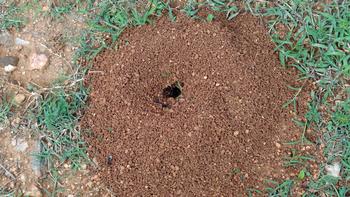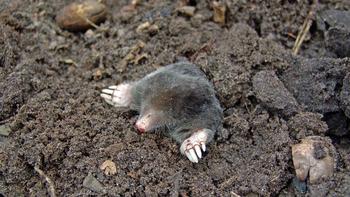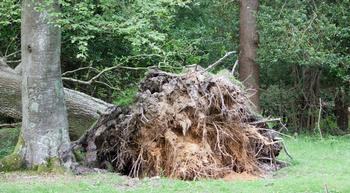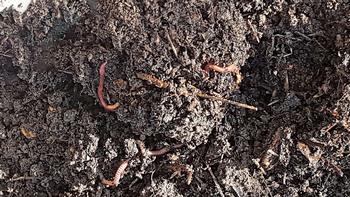The earth movers in healthy soil
-
Nanette Londeree
-
Want fabulous plants? Start with healthy soil. While garden soil may never be glamorous, it is the foundation for a bountiful garden. What you can see going on with your plants above the ground is largely determined by what goes on beneath your feet that is all but invisible to you. The conditions the roots of your plants encounter in the soil will determine whether they thrive or merely survive.
 An ant hill in the garden is a sign that ants are busy tunneling below it. Photo: WikiMedia Commons
An ant hill in the garden is a sign that ants are busy tunneling below it. Photo: WikiMedia CommonsThe living component of soil is perhaps the most important to overall plant health. It’s estimated that a handful of soil contains more organisms than the total number of people that have ever lived on Earth! These diverse creatures decompose organic matter, cycle nutrients, help suppress disease, and mix plant residues into soils and sediments, a process called bioturbation. Whether the mixing is by plant roots that displace the soil, insects, and mammals that burrow and tunnel, or earthworms eating and excreting sediment, the actions create channels within the soil that aids in the movement of gases and water into and through the soil.
Most of the major earth movers are well known, and some are considered pests. Two of the largest size-wise are gophers and moles. These mammals do extensive tunneling and mound building, mixing soil nutrients and improving soil aeration and drainage. Moles also eat many lawn and garden pests, including cranefly larvae and slugs - good for the gardener. Even though their activity may be unsightly, moles are beneficial animals that move soil and eat lawn grubs. Photo: Pexels
Even though their activity may be unsightly, moles are beneficial animals that move soil and eat lawn grubs. Photo: PexelsAnts and termites are pests that you definitely don’t want in your home. But in nature, they do have some benefits. Both are decomposers, breaking down organic matter. Ants move approximately the same amount of soil as earthworms, loosening the soil and increasing air and water movement into the ground. Termites, as they tunnel, help aerate the soil, improving drainage and water infiltration.
Tree roots often run through multiple layers of soil. As they grow, they may disturb or mix sediments. When they fall, they pull older materials to the surface. Tree roots mix soil and they grow, and bring older material to the surface when they fall. Photo: Public Domain Pictures
Tree roots mix soil and they grow, and bring older material to the surface when they fall. Photo: Public Domain PicturesThen some earthworms create intricate networks of tunnels below the ground. Called the "intestines of the earth" by Aristotle, they consume organic matter and mineral particles and excrete wastes in the form of casts, a type of soil aggregate. Their burrowing action moves soil particles closer together near burrow walls, and the mucus they secrete in doing so can also help bind soil particles together. By mixing the soil, they help achieve the proper air, water, and solids ratio for maximum plant growth. Research has shown that soils without earthworms can be 90% less effective at soaking up water. This means water run-off increases which can lead to erosion and, in some cases, flooding.
To keep your soil healthy, and encourage earthworms and other beneficial earth movers to do their jobs, consider these five relatively easy steps: Earthworms have the capacity to eat their own body weight in food every day and move a lot of soil in the process. Photo: WikiMedia Commons
Earthworms have the capacity to eat their own body weight in food every day and move a lot of soil in the process. Photo: WikiMedia Commons- Minimize disturbance: Add organic materials like nature does- laying them on the surface. Let earthworms, Nature’s rototillers, do much of the work.
- Maintain plant diversity: Many of the substances soil microbes feed on are produced by plants. The greater the variety of plants, the more diverse the population of soil microorganisms will be.
- Keep it covered: Soil should always be covered by plants, their residue, or mulch. Cover conserves moisture, helps moderate temperatures, suppresses weed growth, and provides habitat for soil critters that spend some time above ground.
- Add organic material: Any plant or animal material that goes through the decomposition process provides nutrients and habitat to soil microbes, binds soil particles into aggregates, and improves the soil's water-holding capacity.
- Minimize the use of chemicals: The fertilizers and pesticides that gardeners use to enhance plant growth may be toxic to microorganisms in the soil. Adding organic compost rather than synthetic fertilizer and utilizing an integrated pest management approach can help reduce the use of chemicals.




